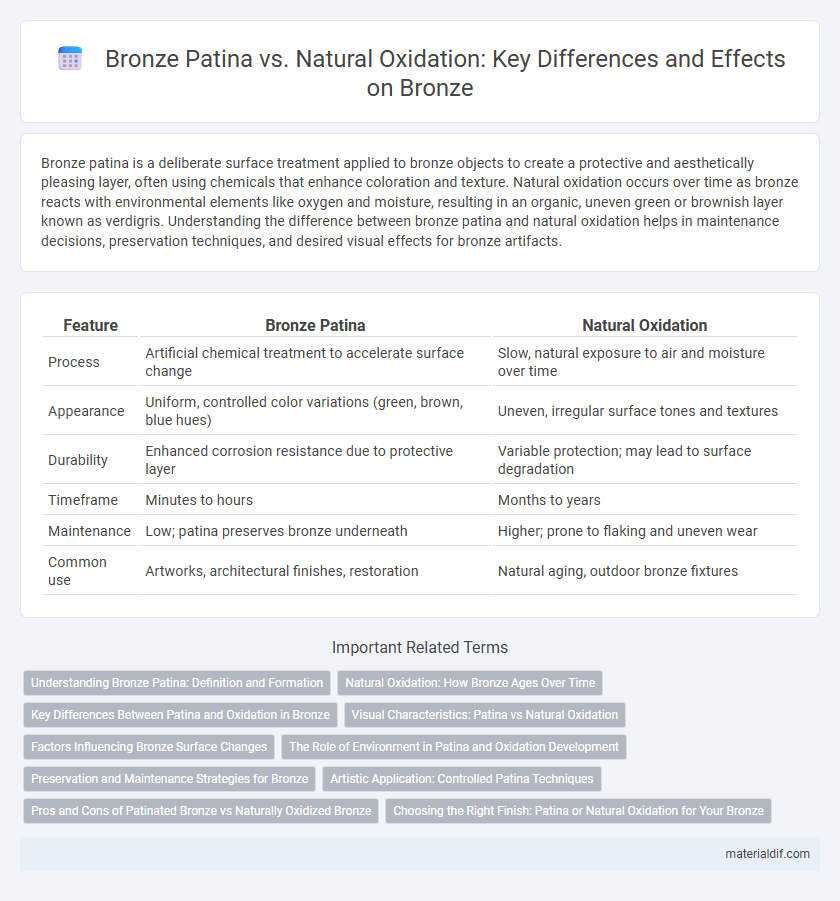Bronze patina is a deliberate surface treatment applied to bronze objects to create a protective and aesthetically pleasing layer, often using chemicals that enhance coloration and texture. Natural oxidation occurs over time as bronze reacts with environmental elements like oxygen and moisture, resulting in an organic, uneven green or brownish layer known as verdigris. Understanding the difference between bronze patina and natural oxidation helps in maintenance decisions, preservation techniques, and desired visual effects for bronze artifacts.
Table of Comparison
| Feature | Bronze Patina | Natural Oxidation |
|---|---|---|
| Process | Artificial chemical treatment to accelerate surface change | Slow, natural exposure to air and moisture over time |
| Appearance | Uniform, controlled color variations (green, brown, blue hues) | Uneven, irregular surface tones and textures |
| Durability | Enhanced corrosion resistance due to protective layer | Variable protection; may lead to surface degradation |
| Timeframe | Minutes to hours | Months to years |
| Maintenance | Low; patina preserves bronze underneath | Higher; prone to flaking and uneven wear |
| Common use | Artworks, architectural finishes, restoration | Natural aging, outdoor bronze fixtures |
Understanding Bronze Patina: Definition and Formation
Bronze patina is a protective surface layer formed through controlled chemical reactions between the metal and environmental elements, resulting in characteristic green, blue, or brown hues. This intentional patination process enhances the metal's aesthetic appeal and increases its resistance to corrosion compared to natural oxidation. Natural oxidation occurs over time due to uncontrolled exposure to moisture and air, often leading to uneven discoloration and potential surface degradation.
Natural Oxidation: How Bronze Ages Over Time
Natural oxidation causes bronze to develop a distinctive patina as it ages, transforming its surface through a gradual chemical reaction with elements like oxygen, moisture, and pollutants. This process results in a protective layer that can range in color from greenish-blue to brown, enhancing both its aesthetic and corrosion resistance. The natural aging of bronze is a slow, irreversible change that preserves the metal's integrity while showcasing its historical and environmental journey.
Key Differences Between Patina and Oxidation in Bronze
Bronze patina forms through controlled chemical processes, often applied intentionally to create a protective and aesthetically pleasing green or brown surface layer. Natural oxidation occurs over time as bronze reacts with atmospheric elements like oxygen and moisture, leading to unpredictable and uneven surface changes. Key differences include the intentionality, uniformity, and chemical stability of patina versus the gradual, inconsistent, and sometimes corrosive nature of natural oxidation on bronze surfaces.
Visual Characteristics: Patina vs Natural Oxidation
Bronze patina develops through controlled chemical treatments, resulting in a smooth, uniform, and often colored surface that enhances aesthetic appeal and artistic value. Natural oxidation forms irregular, rough textures with varied hues depending on environmental exposure, creating a more rustic and organic look. Patina's intentional finish offers consistent visual effects, whereas natural oxidation provides unpredictable and unique visual variation.
Factors Influencing Bronze Surface Changes
Bronze patina develops through controlled chemical treatments or environmental exposure, creating a protective layer that enhances aesthetic appeal and corrosion resistance. Natural oxidation occurs when bronze interacts with air, moisture, and pollutants over time, causing gradual surface changes influenced by factors like humidity, temperature, and atmospheric composition. The rate and appearance of bronze surface alterations depend on alloy composition, exposure duration, and surrounding environmental conditions.
The Role of Environment in Patina and Oxidation Development
Environmental factors such as humidity, temperature, and air pollution significantly influence the development of bronze patina and natural oxidation. High humidity and presence of pollutants like sulfur compounds accelerate the formation of greenish copper carbonate patina on bronze surfaces. In contrast, dry, clean air conditions slow oxidation, resulting in a thinner and more consistent patina layer.
Preservation and Maintenance Strategies for Bronze
Bronze patina forms a protective layer that enhances corrosion resistance and preserves the metal's structural integrity, making it a preferred choice for long-term conservation. Natural oxidation can lead to uneven surface corrosion, requiring more frequent maintenance and careful cleaning to prevent deterioration. Preservation strategies include applying wax coatings or sealants to maintain the patina, while regular inspections help detect early signs of damage caused by environmental exposure.
Artistic Application: Controlled Patina Techniques
Bronze patina offers artists precise control over color and texture, achieved through chemical applications such as liver of sulfur, ferric nitrate, or cupric nitrate solutions, which accelerate oxidation to create vibrant hues ranging from deep browns to verdigris greens. Unlike natural oxidation, which occurs unpredictably over time due to environmental exposure, controlled patina techniques enable consistent and reproducible surface finishes tailored to artistic vision. These methods enhance the aesthetic appeal and longevity of bronze sculptures by stabilizing the surface layer, preventing further corrosive damage while promoting desired visual effects.
Pros and Cons of Patinated Bronze vs Naturally Oxidized Bronze
Patinated bronze offers a controlled and uniform surface finish that enhances aesthetic appeal and provides additional corrosion resistance, making it ideal for architectural and artistic applications. Naturally oxidized bronze develops an organic and unique patina over time, which can be unpredictable and may require maintenance to prevent further degradation. While patination ensures consistent protection and color, natural oxidation emphasizes authenticity and aging character, each presenting distinct advantages depending on preservation goals and visual preferences.
Choosing the Right Finish: Patina or Natural Oxidation for Your Bronze
Choosing between bronze patina and natural oxidation depends on the desired aesthetic and durability of the finish. Bronze patina involves applying chemical solutions to create a controlled, often colorful surface layer that enhances corrosion resistance and visual appeal. Natural oxidation allows bronze to develop a unique, organic layer over time, offering a rustic, weathered look that requires less maintenance but may vary unpredictably in color and texture.
Bronze Patina vs Natural Oxidation Infographic

 materialdif.com
materialdif.com